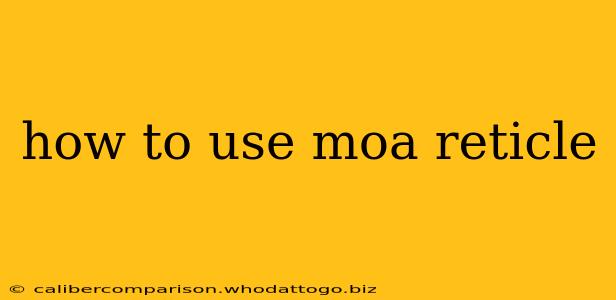The MOA (Minute of Angle) reticle is a popular choice among shooters, offering precise aiming capabilities at various ranges. Understanding how to effectively utilize an MOA reticle requires a grasp of its fundamentals and practical application. This guide will provide a comprehensive walkthrough, empowering you to leverage the full potential of your MOA-equipped optic.
Understanding the MOA System
Before diving into practical application, let's establish a firm understanding of what an MOA represents. One MOA subtends approximately 1 inch at 100 yards. This means that at 100 yards, a 1 MOA dot will cover a 1-inch area. At 200 yards, it will cover 2 inches, and so on. This consistent scaling is crucial for accurate ranging and holdover adjustments.
Types of MOA Reticles
Several types of MOA reticles exist, each with its own advantages and disadvantages. Some common variations include:
- Simple MOA Dot: Features a single dot, ideal for quick target acquisition at closer ranges.
- MOA Crosshairs: A crosshair design with MOA increments marked along the horizontal and vertical lines, allowing for precise holdovers and windage adjustments.
- MOA BDC (Bullet Drop Compensator) Reticle: Incorporates holdover points calibrated for specific ammunition and ranges, simplifying long-range shooting.
The choice of reticle depends heavily on your shooting style and the types of targets you engage.
Using an MOA Reticle for Accurate Shooting
Effectively using an MOA reticle involves several key steps:
1. Zeroing Your Weapon
Accurate zeroing is paramount. This involves adjusting your scope's elevation and windage turrets to ensure your point of impact matches your point of aim at a specific zeroing distance (often 100 yards). This establishes a baseline for all subsequent adjustments.
2. Understanding Your Ammunition's Ballistics
Understanding your ammunition's ballistic characteristics (bullet drop, wind drift) is crucial for accurate long-range shooting. This information, often available from the manufacturer or through ballistic calculators, is essential for effective use of an MOA BDC reticle or for calculating holdovers with a standard MOA reticle.
3. Calculating Holdovers and Windage Adjustments
Once zeroed, you'll use the MOA markings on your reticle to compensate for bullet drop at longer ranges. Remember:
- Bullet Drop: As the bullet travels, gravity causes it to drop. You'll need to aim higher to compensate for this drop. The MOA markings on your reticle help you determine how much higher.
- Wind Drift: Wind pushes the bullet off course. You'll need to adjust your aim accordingly, using the horizontal MOA markings on your reticle.
4. Practical Application on the Range
Practice is key. Spend time on the range, engaging targets at various distances. This allows you to hone your skills and develop muscle memory for making accurate holdovers and windage adjustments. Start with shorter ranges to build confidence before progressing to longer distances.
Common Mistakes to Avoid
- Incorrect Zeroing: A poorly zeroed rifle will render any MOA calculations useless. Ensure proper zeroing before attempting long-range shots.
- Ignoring Environmental Factors: Wind speed and direction, as well as temperature and altitude, all affect bullet trajectory. Ignoring these factors will lead to inaccurate shots.
- Neglecting Practice: Mastering an MOA reticle requires consistent practice. Don't expect to become proficient overnight.
Conclusion
The MOA reticle, while requiring a degree of understanding, offers unparalleled precision for long-range shooting. By grasping the fundamentals, understanding your ammunition's ballistics, and dedicating time to practice, you can harness the power of the MOA system for consistently accurate shots. Remember that responsible firearm handling and safe shooting practices are paramount.

